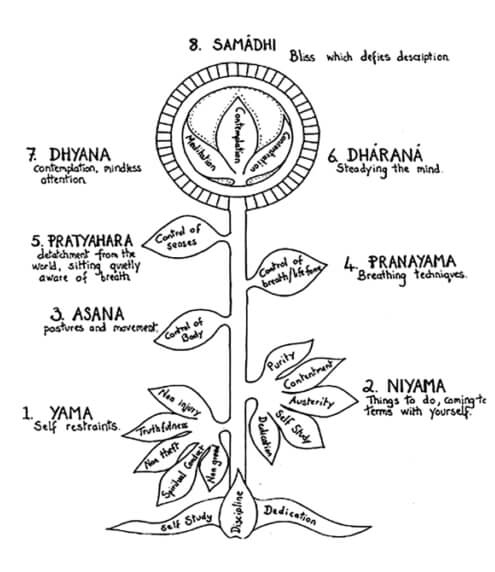The word Yoga comes from the Sanskrit word yuj, which means “to attach, join, harness, yoke”, and signifies union of the individual and universal conscious. It is one of the most precious gifts given by the ancient Indian sages to humankind. In last few decades, the word “Yoga” has been used to refer to practise of performing physical postures or Asanas, with the goal of physical fitness. However in actuality, it is a complete system, of which the postures are a small, though quite useful part.
History of Yoga

Yoga is widely considered as an “immortal cultural outcome” of the Indus Saraswati Valley Civilisation – dating back to approximately 2700 BC. A number of seals and fossil remains of Indus Saraswati Valley Civilisation with Yogic motifs and figures performing Yogic sādhana suggest the presence of Yogic practises in ancient India.
Ancient Times: Yoga as a Philosophy
References to Yoga are also available in ancient Vedic and Upanishadic heritage, Buddhist and Jain traditions, Darshanas, epics of Mahabharata including Bhagawadgita and Ramayana, theistic traditions of Shaivas, Vaishnavas and Tantric traditions. The Vedas expounded a diverse set of practices, ideas and concepts; six main schools of philosophy emerged from these teachings. They are: Nyaya (logic), Vaiseshika (analysis of the universe), Samkhya (classification of the universe), Yoga (union with the Divine), Mimansha (ritual interpretation of the Vedas), and Vedanta (inquiry into the Self).
The Yoga School of Philosophy:
This school advocates working with two fundamental realities: purusha, meaning “pure consciousness,” and prakriti, meaning “matter.” Every living being is a form of connection of these two realities and every living being is considered a union of body and mind. The path of yoga is guided by ethical principles, yamas and niyamas, and should ultimately result in moksha (spiritual liberation).
History of Yogic Practises
Maharishi Patanjali systematised and codified the then existing Yogic practices, its meaning and its related knowledge through Patanjali’s Yoga Sutras. After Patanjali, many sages and Yoga masters contributed greatly for the preservation and development of the field through well documented practices and literature.
Yoga in Modern Times
In the late 1800s and early 1900s, yoga masters began to travel to the West, attracting attention and followers. In 1893, Parliament of Religions in Chicago, Swami Vivekananda lectured on yoga and the universality of the world’s religions. In the 1920s and 30s, Hatha-Yoga was strongly promoted in India with the work of T. Krishnamacharya, Swami Sivananda and other yogis practicing Hatha-Yoga. Krishnamacharya opened the first Hatha-Yoga school in Mysore in 1924 and in 1936 Sivananda founded the Divine Life Society on the banks of the holy Ganges River.
Recent Developments
On 11 December 2014, the United Nations General Assembly (UNGA) with 193 members approved the proposal to celebrate ‘June 21’ as the ‘International Yoga Day’. The sixth edition of IYD will be celebrated on 21st June 2020. This year, due to the on-going Corona Virus Pandemic, no mass gathering would be advisable this year. Hence, this year the ministry is encouraging people to practice yogic asanas at their homes, with participation from the entire family. Accordingly, the theme of International Yoga Day 2020 has been kept as ‘Yoga At Home With Family‘

Four Paths of Yoga
The Bhagavad Gita introduces distinctions such as Jnana-Yoga (based on knowledge) vs. Karma-Yoga (based on action). In time, the different philosophies, traditions, lineages and Guru-shishya paramparas led to the emergence of different traditional schools or paths.
Jnana: The path of knowledge, wisdom, introspection and contemplation.
Bhakti: The path of devotion, emotion, love, compassion, and service to God and others.
Karma: The path of action, service to others, mindfulness, and remembering the levels of our being while fulfilling our actions or karma in the world.
Raja: A comprehensive method that emphasizes meditation, while encompassing the whole of Yoga.

Eight Limbs of Yoga
In his “Yoga Sutras” (aphorisms) Maharishi Patanjali “Ashtanga Yoga” for all-round development of human beings. In Sanskrit ‘Ashtanga’ is “Ashta + anga” where “Ashta” means Eight and “Anga” is limbs so Ashtanga means Eight Limb path. These 8 limbs are
- Yama (social ethics),
- Niyama (personal ethics),
- Asana (postures),
- Pranayama (life force),
- Pratyahara (turning the senses inwards),
- Dharana (one-pointed focus),
- Dhyana (meditation),
- Samadhi (merging with the self).
Yoga: A Way of Life
Yoga is not limited to the physical postures, breathing techniques or meditation only, rather it is also a way of life. It propounds several principles including asana, pranayama, kriya, mudra, bandha and meditation, which are relevant to healthy living. Yogic principles of healthy living are equally beneficial and can be adopted by all, irrespective of age, gender or profession. The components of yogic way of life are:
Ahara
There is emphasis on mitahara, which are related to quality and quantity of food and also the state of mind during the intake of food. Right quality mithara advocates eating freshly cooked, nutritious, nourishing and in the natural form. Regarding quantity of food, mitahara mentions that two quarters of the stomach should be filled with food, one quarter of stomach should be filled with liquid and the remaining quarter (one‐fourth) of the stomach should be left empty for free flow of air. Mitahara also advocates that the food should be eaten with positive state of mind with utmost concentration.
Vihara
Vihara means relaxation, which can be brought about by activities such as exercise, recreation and creative activities like drawing, painting, singing, etc. Yogic practices of asana, pranayama and meditation relax body and mind. Sound sleep is also equally important for relaxation.
Achara
Achara means conduct that includes emotions, attitudes, desires, instincts and habits. Positive emotions, positive attitudes, good habits and control on desires help in making us strong, both, individually and socially. Yogic principles of Yama (restraint) and Niyama (observance) help to develop control on our desires and emotions and bring about peace and harmony.
Vichara
Our thinking should be positive. Positive thoughts bring pleasure in our life; while negative thoughts can make us unhappy. Yogic practices like pratyahara, and dhyana (meditation) help in controlling our thoughts and thereby promoting optimism in life.
Vyavahara
Vyavahara (behaviour) means actions. Vyavahara is the result of ahara, vihara, achara and vichara. Karma-Yoga proposes that we should perform right act with full dedication without worrying about the results.
Yoganidra
Yoganidra means ‘sleep’ with awareness. Yoganidra is a state of mind in between wakefulness and dream. In normal sleep, one sleeps without awareness. But in yoganidra one sleeps with awareness. Yoganidra is helpful in management of stress. It relaxes body and mind and reduces tension. Yoganidra is practised in Shavasana. It consists of body awareness and breath awareness. The awareness is rotated in quick succession through all parts of the body, then it is taken to the breath and finally to the mind.

Yoga Asanas
Maharishi Patanjali defines asanas as Steady and Comfortable pose. It is a pose or posture or position of the body.
Yogasana embodies unity of mind and body; thought and action; restraint and fulfilment; harmony between man and nature and a holistic approach to health and well-being. Performing Asanas is not about exercise but to discover the sense of oneness with ourselves, the world and nature.
Āsanas, involve adopting various psychophysical body patterns and give one an ability to maintain a body position (a stable awareness of one’s structural existence) for a considerable length of time and so their practise results in stability of body and mind.
Watch Ahead
Commonyoga Protocol 2020 – Youtube Playlist
Yogasanas with IRA Trivedi | DD National Learning Yoga Series – Youtube Playlist
Yogasana | Rajya Sabha TV – Youtube Playlist
Benefits of Yoga
The United Nations General Assembly recognised that Yoga provides a holistic approach to health and well-being. Yogic way of life brings harmony in all walks of life and thus, is known for disease prevention, health promotion and management of many lifestyle related disorders. Yogic practices are found effective for development of all dimensions of personality.
- Physical Dimension: Yogic practices like asana, pranayama, and bandha play a beneficial role in physical development of body.
- Emotional Dimension: Yogic practices such as yama, niyama, asana, pranayama, pratyahara and meditation help in emotional management.
- Intellectual Dimension: Yogic practices such as asana, pranayama, dharana, dhyana (meditation) help to develop concentration, memory and thereby help in intellectual development.
- Social Dimension: Following the codes of Yama and Niyama helps betterment of relationships with our friends, parents, teachers and others.
- Spiritual Dimension: For spiritual development, yama, niyama, pratyahara and dhyana (meditation) are helpful. Yama and niyama help to develop moral values while pranayama, and meditation help us to realise our true self. Introspection is a very effective for the development of ‘self’.
Photo by Jared Rice | Simon Rae

